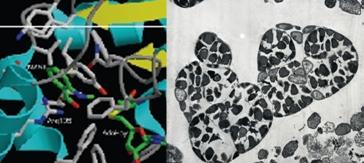|
|
Biology of Methanogenesis |
Department of Marine Biotechnology UMBC - Institute of Marine & Environmental Technology
Annotation of novel enzymatic functions in methanogens
Traditional approaches have relied on genetic mutants and biochemical analysis to determine all of the steps in these metabolic or biosynthetic pathways. But sequencing the complete genomes of numerous organisms, which reveals all of the genes of each organism, has revealed important gaps in our knowledge. Scientists have found that a substantial proportion of these genes, as many as 25-70%, depending on the organism, have unknown or poorly understood function. A significant proportion of these “hypotheticals” encode putative enzymes whose precise catalytic function, and substrate, are yet to be determined. This collaboration sutilizes a comprehensive approach to discover the precise functions and substrates of putative enzymes in an especially interesting microorganism, Methanosarcina acetivorans. By combining genetics, molecular biology, and physical techniques, the investigators will produce mutations to reveal specific substrates and enzymatic functions, in a systematic manner. This will lead to the characterization of numerous unknown enzymes and their substrates. This knowledge will be applicable not only to new energy sources and waste processing, but also to understanding the biochemistry of other kinds of cells that have unknown enzymatic functions, including human cells. While the immediate focus is on methanogens, the long-term goal is to develop an integrated platform for annotating putative enzymatic functions that can be used for a wide range of organisms. In order to determine the functions and substrates of these enzymes, each of the investigators in this study brings his particular area of expertise to the collaboration. Dr. Orban is an expert in NMR (nuclear magnetic resonance spectroscopy), a physical technique that can be used to determine the structures of small molecules and larger proteins with which they interact. Dr. Orban has used this technique in the past to characterize orphan genes. Dr. Zvi Kelman is a biochemist with extensive experience in characterizing proteins from archaeal-cells. Dr. Kevin Sowers is an expert in the physiology and molecular biology of methane-producing Archaea. Dr. Basil Nikolau is an expert in the new field of metabolomics, which characterizes small molecule substrates of living cells.
 Additional Information
Additional Information
G2F Webpage
 Collaborators
Collaborators
John Orban, Ph.D., Center for Advanced Research in Biotechnology
Zvi Kelman, Ph.D., Center for Advanced Research in Biotechnology
Basil Nikolau, Ph.D., Iowa State University
 Project Team
Project Team
Ethel Apolinario
Publications and Presentations
Menezes, S., K. Gaston, K. Krivos, E.E. Apolinario, N.O. Reich, K.R. Sowers, P.A. Limbach, J.J. Perona. 2011. Formation of m2G6 in Methanocaldococcus jannaschii tRNA catalyzed by the novel methyltransferase Trm14. Nucl. Acids Res. 39(17): 7641-7655
Chen, Y., Apolinario, E., Brachova, L., Kelman, Z., Li, Z., Nikolau, B. J., Showman, L., Sowers, K., and Orban, J. 2010. An integrated approach to accurate functional annotation of putative enzymes in the methanogen M. acetivorans. BMC Genomics 12(Suppl 1): S7.
Ethel Apolinario, Yihong Chen, Zvi Kelman, Zhuo Li, Basil Nikolau, Kevin Sowers, Eric Testroet and John Orban. An integrated approach to experimental validation of putative gene functions in M. acetivorans. Gordon Research Conference on Archaea: Ecology, Metabolism and Molecular Biology. July 26-31, 2009, Waterville Valley, NH.
E. Apolinario, Z. Kelman, J. Li, B. Nikolau, K. Sowers. Annotation of novel enzymatic functions in methanogens. GTL Awardee Workshop VI and Metabolic Engineering 2008. February 10-13, 2008. Bethesda, MD.
Sowers, K.R. and K. Anderson. 2007. Molecular Genetics of Archaea. In: R. Cavicchioli (ed.), Archaea: Molecular Cell Biology. American Society for Microbiology, Washington, D.C. , pp. 463-477. ISBN: 978-1-55581-391-8.
Related
Publications and Presentations
Maeder, D.L., I. Anderson, T. Brettin, D. Bruce, P. Gilna, C. S. Han, A. Lapidus, W.W. Metcalf, E. Saunders, R. Tapia, and K.R. Sowers. 2006. The Methanosarcina barkeri genome: comparative analysis with Methanosarcina acetivorans and Methanosarcina mazei reveals extensive rearrangement within methanosarcinal genomes. J. Bacteriol. 188: 7922-7931.
Apolinario-Smith, E., K.M. Jackson, and K.R. Sowers. 2005. Development of a plasmid-mediated reporter system for in vivo monitoring of gene expression in the archaeon Methanosarcina acetivorans. Appl. Environ. Microbiol. 71: 4914-4918.
Galagan, J.E., et al.. 2002. The genome of Methanosarcina acetivorans reveals extensive metabolic and physiological diversity. Gen. Res. 12: 532-542.
Metcalf,
W.W. , J.K. Zhang, E. Apolinario, K.R. Sowers, and R.S. Wolfe.
1997. An archaeal gene
transfer system for Methanosarcina spp.:
liposome-mediated transformation and construction of shuttle vectors.
Proc. Nat. Acad. Sci. USA 94: 2626-2631.
Funded by

